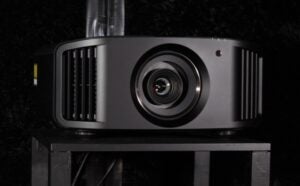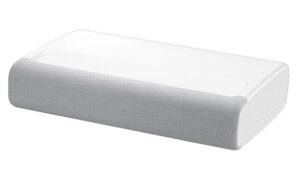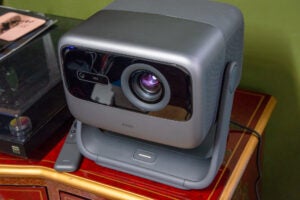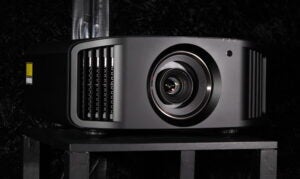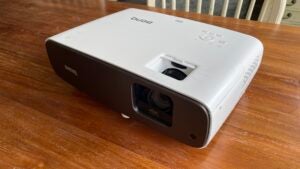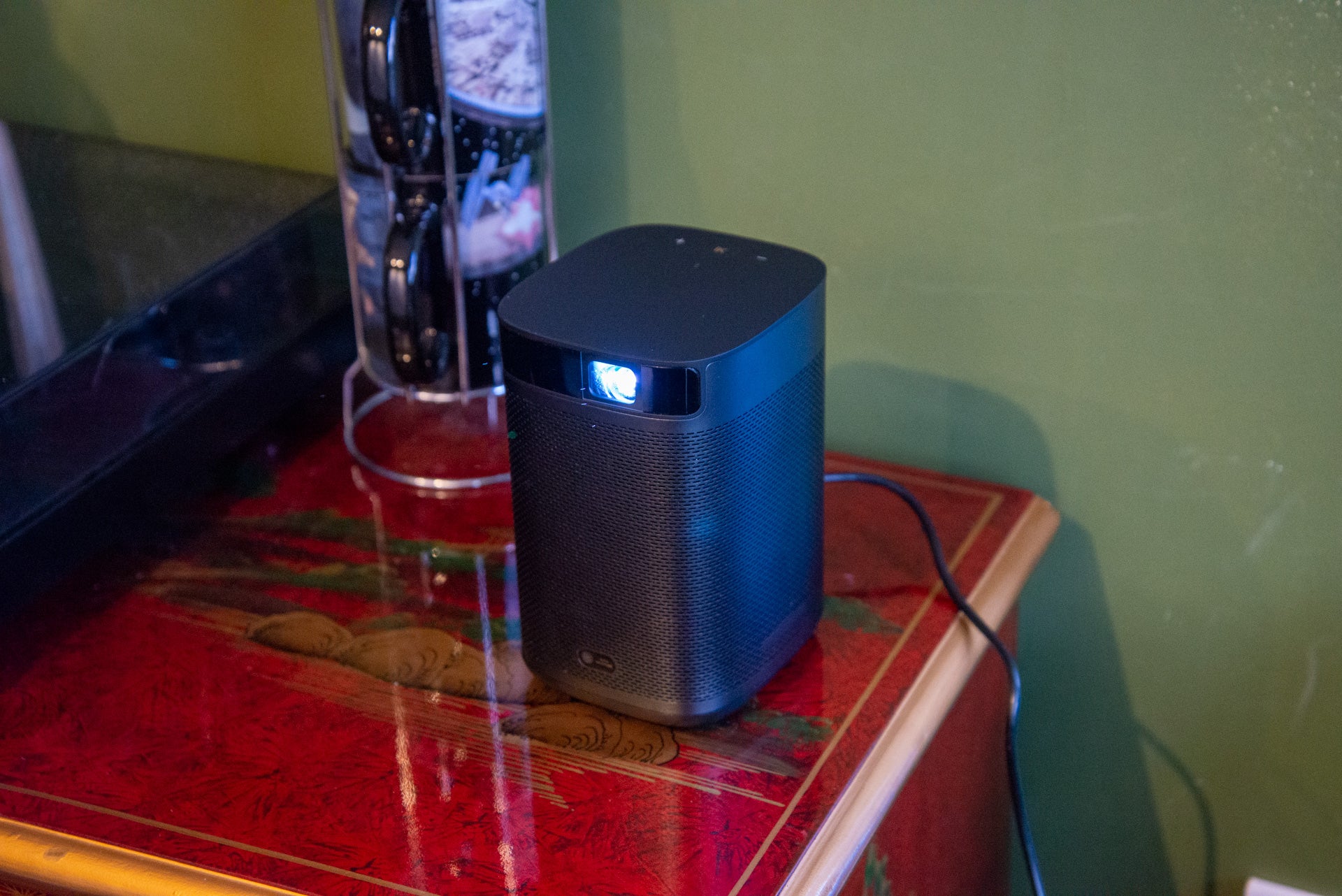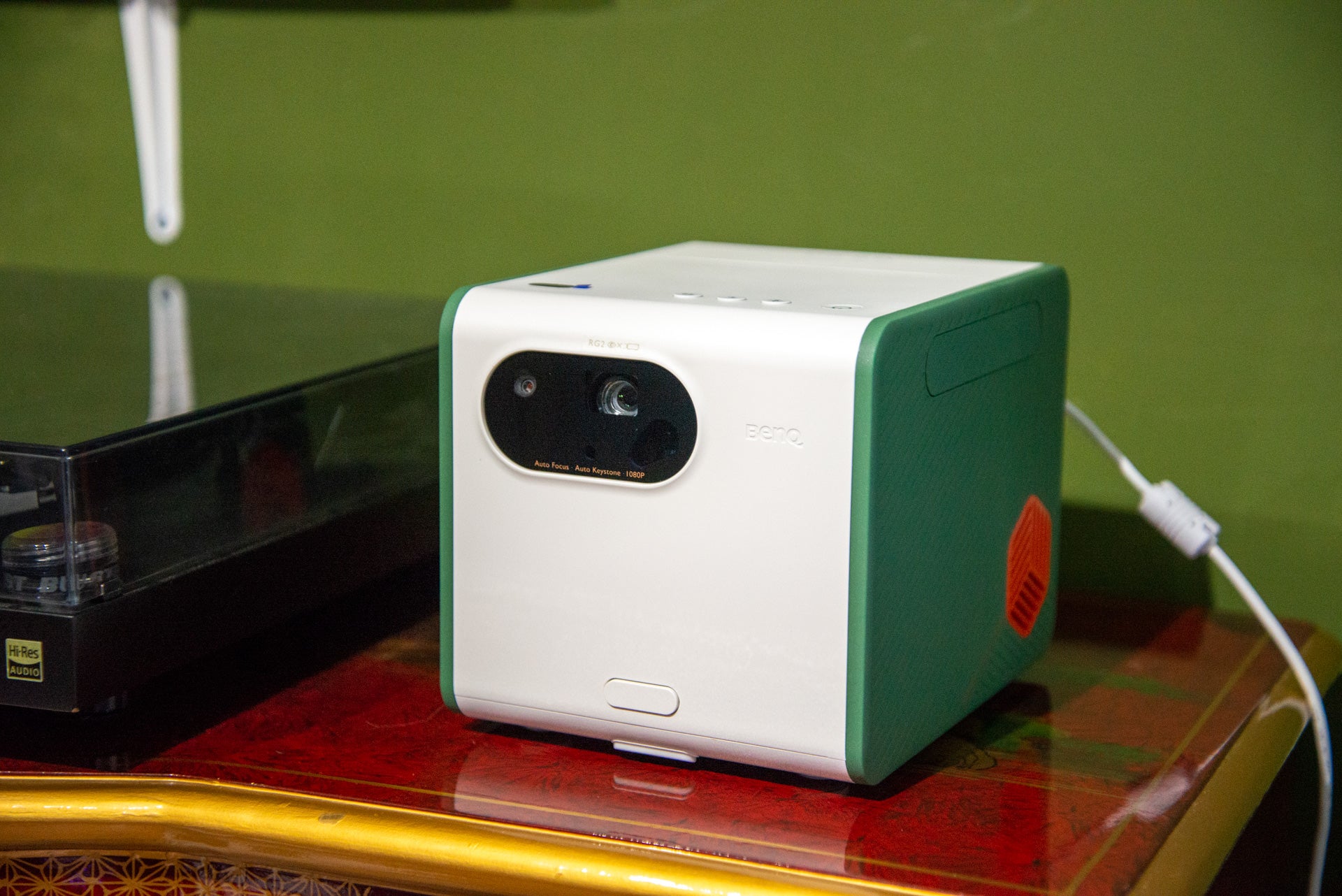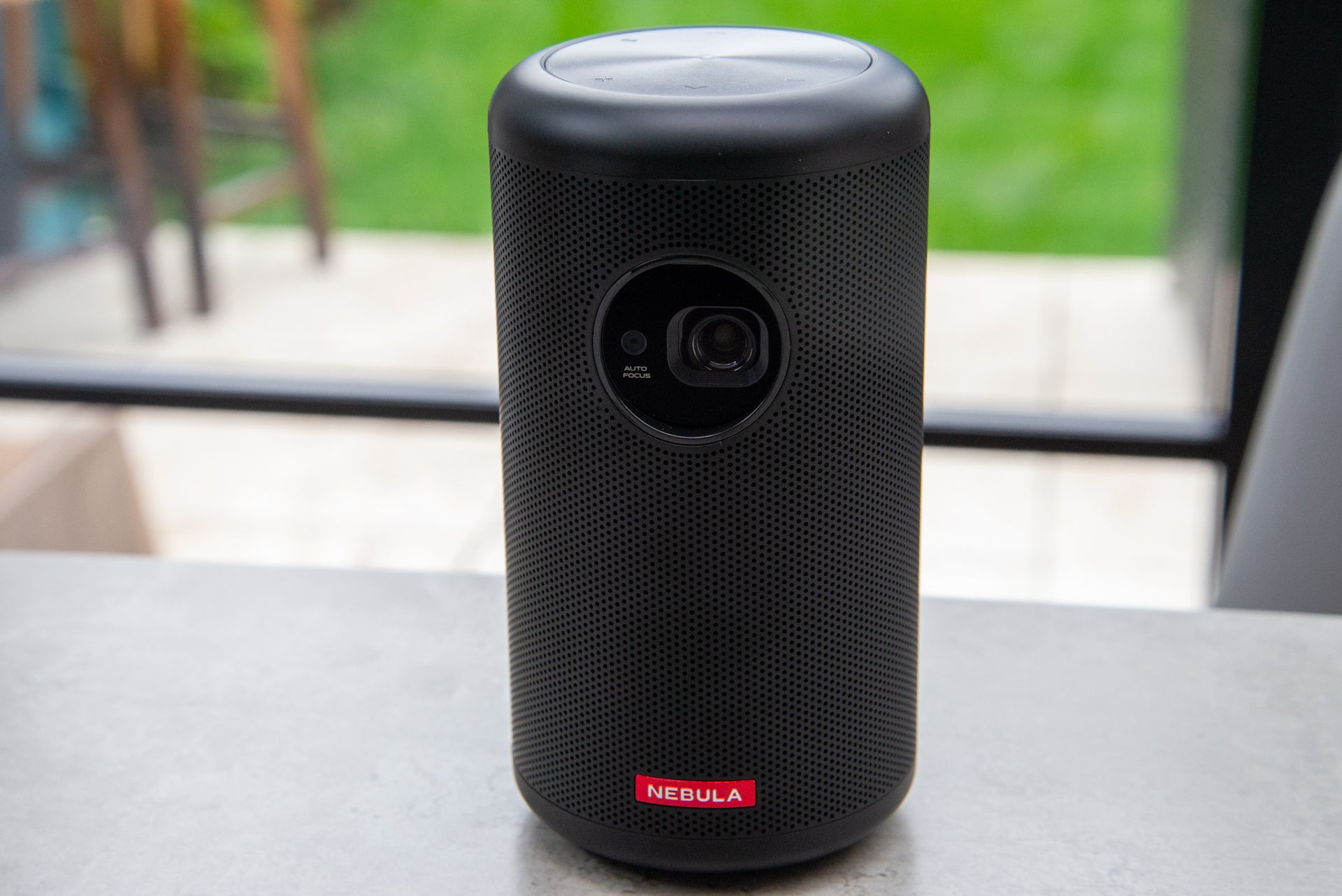Best projectors 2023: The biggest screen in the home
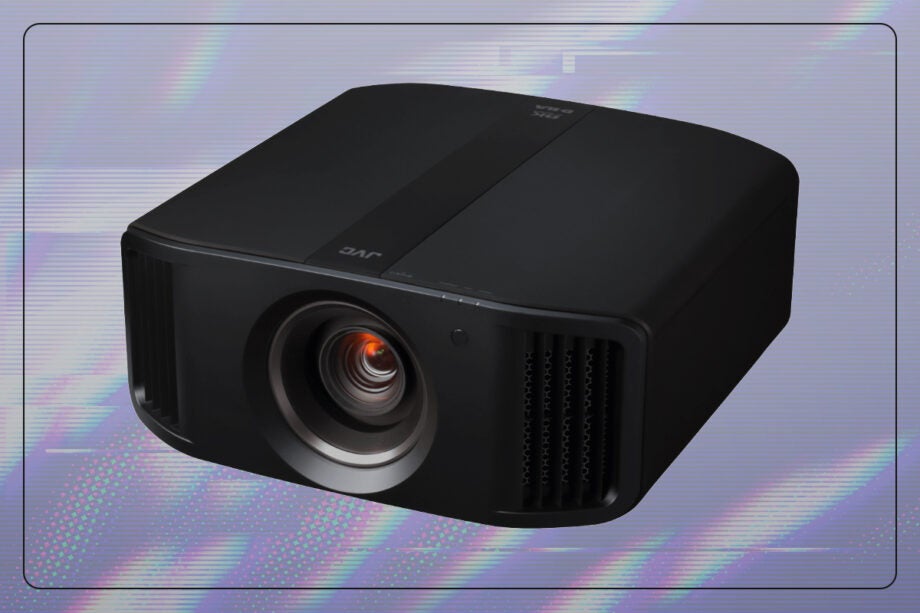
There’s no better way than a projector to bring the cinema experience direct to your home. There are all types projector to choose from for casual and home cinema fanatics – you just need to know which one is best for you.
And so, to find the best projectors, we’ve come up with this list that features affordable, portable and higher-end projectors to cover everyone from the budding cinema fan to the cinema enthusiast.
We’ve tested these projectors by watching films at home or in dedicated cinema rooms, used them various lighting conditions and even using them in the garden when necessary to judge their performance.
We consider the size of the projector is and whether it requires a dedicated installation or not. What type of room it works best in, the quality of its construction and how much noise the fan makes. And of course there’s picture performance to take into account too, as well as how it handles HDR content, upscaling and motion. If it has speakers we’ll take that into consideration as to whether they are good enough or if you should budget for a sound system.
Our purpose is to try and make life easier with our selection of best projectors. If something hasn’t caught your eye, then check out our other projector related best buys, which include our best outdoor projectors and our best portable projectors.
Best projectors at a glance
- Best home cinema projector: JVC DLA-NZ8 – check price
- Best premium gaming projector: JVC DLA-NZ7 – check price
- Best premium portable projector: JMGO N1 Ultra – check price
- Best mid-range 4K projector: BenQ W2710i – check price
- Best ultra short-throw projector: Samsung Premiere LSP9T – check price
- Best portable projector: Samsung Freestyle – check price
- Best affordable projector: Optoma UHD38 – check price
How we test
We test projectors by, well, watching lots of movies on them. But not just movies: we watch sports and TV programmes to get a sense of how they work in terms of motion, sharpness, detail and overall image fidelity.
Depending on the projector, we’ll test them in a bespoke home cinema room or in our own rooms and gardens to see if they live up to the manufacturer’s claims about their performance.
If it’s an HDR projector, we’ll watch plenty of HDR content to determine if colours are correct and whether the projector can do a decent approximation of HDR. If it’s a gaming projector we’ll test the latency to determine how responsive it is.
We’ll also assess the projector in terms of its size and whether it needs a dedicated installation, as well as how much noise it makes during operation and whether that can be a hindrance to watching content. Are they easy to use? And do they require more expert knowledge to operate are considerations we also take into account.
With our reviewers knowledge of previous projectors tested, they’ll be considered to what’s come before to determine whether they offer good value, regardless of how much or how little they cost.
- Super-accurate images
- Bright big-screen performance
- Class-leading black levels
- Flawless HDR tone mapping
- Excellent build quality
- It isn’t exactly small
- You’ll need deep pockets
- Remarkably bright, colourful pictures
- Compact, living-room friendly design
- Built-in tuner and TV-like smart system
- It’s not cheap for this sort of projector
- Loss of colour finesse in very dark scenes with certain presets
- Rainbow effect
- Easy-to-setup big screen images
- Surprisingly good sound
- Built-in streaming apps
- Limited to Full HD resolution
- Colour gamut could be wider
- Seriously bright, crisp images
- Super-fast response time in Enhanced Gaming mode
- Bold colour and HDR performance
- Black levels are very average in HDR
- Some clipping with HDR
- Long-throw lens seems an odd choice for a gaming projector
- Extremely bright
- Excellent image quality
- Flexible stand
- Stand doesn’t have a tripod mount
- No native Netflix
- Bright and punchy images
- Exceptional accuracy
- Excellent blacks and contrast
- Class-leading HDR performance
- Superb fit and finish
- Not exactly discreet
- Not cheap either
- Outstandingly sharp, detailed 4K pictures
- Superb colour handling right out of the box
- HDR10+ playback
- Hyperactive ‘High’ dynamic iris setting
- Minor rainbow effect
- Mixed bag smart system
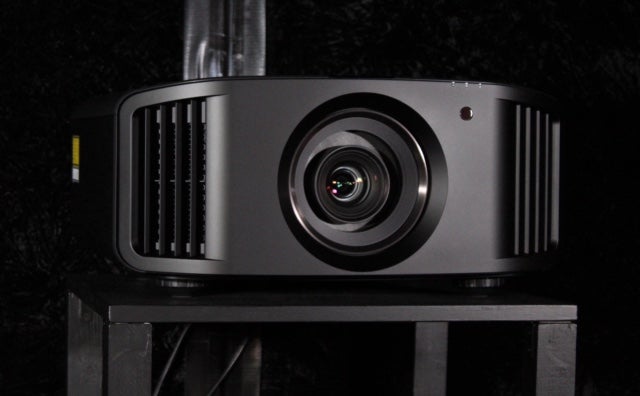
JVC DLA-NZ8
Best home cinema projector
Pros
- Super-accurate images
- Bright big-screen performance
- Class-leading black levels
- Flawless HDR tone mapping
- Excellent build quality
Cons
- It isn’t exactly small
- You’ll need deep pockets
This JVC projector is among the most expensive we’ve tested, but its position at the top of this best list is reflective of just how good it is.
$15,000 / £15,000 is a lot to pay for any projector but in our opinion, there aren’t many projectors as well specified as the NZ8. The DLA-NZ8 is part of JVC’s new range of projectors that feature a BLU-Escent laser light source for increased brightness, more consistent image and a longer lifespan of 20,000 hours compared to lamp-based projectors.
While we couldn’t possibly ascertain whether the lifespan works out (we’d be here for years), our reviewer found that the NZ8 delivered awesome native 4K images with remarkable levels of detail, retaining the film-like-quality that JVC’s projectors are known for. Images are bright and clean, the black levels deep and rich, and when combined with the increased brightness, we found the JVC delivered images with a real sense of pop and highly accurate colours.
It has double the contrast ratio of the entry-level NZ7, but in our opinion you’d barely notice the difference between the two projectors’ contrast performance unless you’re in a blacked-out room.
The two HDMI 2.1 inputs can support refresh rates up to 120Hz, which would make this a premium option for high-end gaming. With an input lag of 38ms, it doesn’t compare well to the LG C2 TV, but for a projector that’s a very good responsive time.
The NZ8 is able to accept 8K signal and put it on screen via its 8K/e-shiftX processing. Other features include HDR support, with HDR10+ to help optimise supported HDR content on 4K Blu-ray and Prime Video streaming. If you’re still into 3D, this projector has support for it, with a performance we found to be bright, accurate and free of any ghosting, although you will need to purchase the optional RF transmitter and glasses.
Reviewer: Steve Withers
Full Review: JVC DLA-NZ8
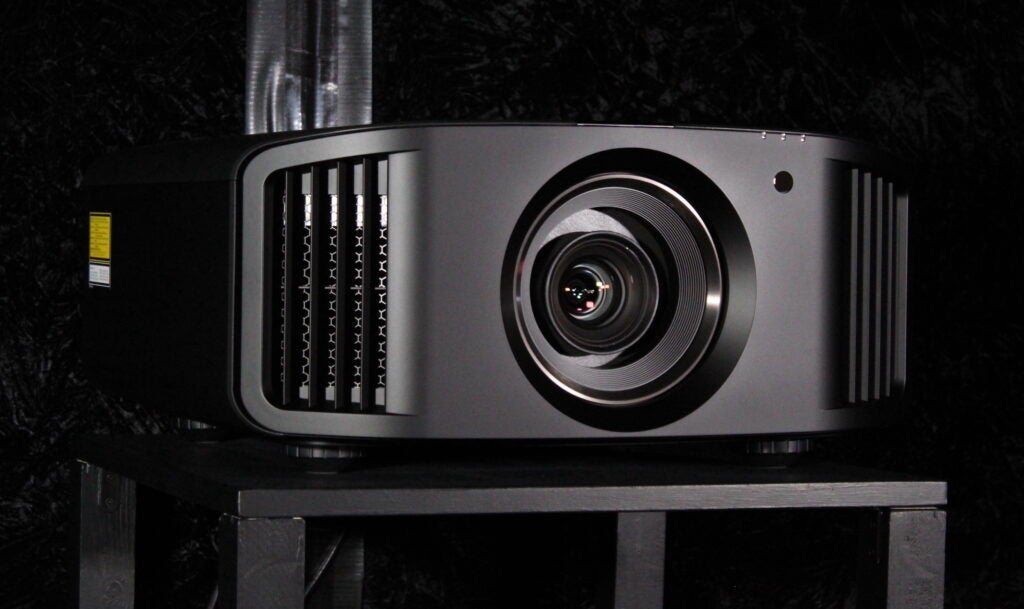
JVC DLA-NZ7
Best premium gaming projector
Pros
- Bright and punchy images
- Exceptional accuracy
- Excellent blacks and contrast
- Class-leading HDR performance
- Superb fit and finish
Cons
- Not exactly discreet
- Not cheap either
JVC’s NZ7 is considered to be the entry-level option within the brand’s newest projector range, priced at $10,999 / £11,499. Enormous cost aside, this is an 8K projector that takes few prisoners on a performance level, feature a lamp-based lighting system, native 4K HDR and higher frame support for gaming.
The NZ7 uses the same glass 65mm lens element as the more expensive NZ8 but lacks the coating inside to help enhance contrast ratios and suppress reflected light. Even so, its claimed contrast ratio of 40,000:1 is better than rivals such as the Sony VPL-XW7000ES.
It features two HDMI 2.1 certified ports that can accept 8K/60p and 4K/120p images, and there’s HDR support in the form of HDR10, HLG and HDR10+. Our reviewer found the HDR performance to be class-leading with the premium home cinema market, a watch of The Shining in HDR10+ revealed deeper blacks, more detailed shadows and white snowy surfaces free of any clipping (loss of detail) in the brighter parts of the image.
In general the JVC DLA-NZ7 delivers an awesome 4K image, with what we felt were remarkably detailed native 4K images that retain a film-like appearance, as well as highly accurate colour gamut (range), and a big and bright image. Motion handling is excellent, with images free of any judder or blurring with 24p content. This level of excellence also helps with games that have frame rates up to 120Hz, and with a latency of just 38ms (which is good for a projector), the JVC can provide a high-end gaming experience for a projector.
SDR (Standard Dynamic Range) images are produced with no artefacts, deep blacks and accurate colours, and if you’re still interested in the 3D format, then our reviewer felt the performance here was equally as fantastic as the rest of the JVC’s picture, with big, bright and accurate images. You will need to purchase the optional RF transmitter and glasses, but we don’t think you’ll be disappointed if you do.
While a significant investment, the JVC NZ7 puts in an awesome performance across the board. If you want something smaller for portable use, the JMGO N1 Ultra is a less expensive alternative but for gaming, watching TV and films in the home, there aren’t many projectors as good as the JVC.
Reviewer: Steve Withers
Full Review: JVC DLA-NZ7

BenQ W2710i
Best mid-range 4K projector
Pros
- Outstandingly sharp, detailed 4K pictures
- Superb colour handling right out of the box
- HDR10+ playback
Cons
- Hyperactive ‘High’ dynamic iris setting
- Minor rainbow effect
- Mixed bag smart system
It’s been a few years since the W2700 was released, so we were pleased as punch to see its successor arrive in the W2710i, a projector aimed at home cinema enthusiasts that sits within the mid-range of the market.
Our reviewer observed that the W2710i follows the same living room-friendly design template BenQ has used for many years. Its reasonably compact size allows it to fit comfortably onto almost any coffee or side table, and its three screw-down feet help angle the image correctly onto a screen or wall, and we’d recommend owning or getting a screen for a projector such as this.
The W2710i supports 4K and HDR, though it isn’t necessarily native 4K as the projector uses some clever tricks to create the illusion of ‘proper’ 4K.There are plenty of features to talk about with the W2710i but the most important is that BenQ claims it covers 95% of the DCI-P3 colour range and the full coverage of the SDR Rec 709 spectrum.
It can achieve a brightness of 2200 lumens, which is an increase on the W2700 for slightly brighter images, and there’s support for Filmmaker mode to get close to viewing content as it was mastered. There’s also a special port for a BenQ Android TV smart dongle to stream media with support for apps such as Disney+, Netflix, ITVX, Amazon Prime Video, Now, Apple TV, and Paramount+. Disappointingly, there’s no support for iPlayer or Channel 4.
We found set-up to be a breeze as its optical zoom and optical vertical image shifting gives the user a decent degree of flexibility in terms of placement, while an effective auto keystone adjustment helps get the edges of the image to where it needs it to be.
The W2710i improves on the performance of its predecessor in a number of areas – and in our humble opinion it’s easily one of the best projectors in its class. Images look incredibly sharp and detailed, with good quality native 4K sources looking absolutely pristine, packed with detail and textures no HD image could give you. We also observed that its sharpness doesn’t take a hit when there’s motion to deal with, the W2710i’s 24p True Cinema option serving up one of the most natural and relaxed looking 24p experiences we’ve seen on any projector.
HDR tone mapping is good, enjoying more vibrancy and volume than we’ve seen on other similarly priced projectors, though we did notice that skin tones can look a little suntanned with the projector’s out-of-the-box settings.
The sound system developed by BenQ’s internal Trevolo division is one of the better ones we’ve come across. It’s well-rounded, less harsh and projects audio away from its body well. If you’re sitting behind the projector, we noticed that it does feel as if it comes from the screen.
BenQ is launching another projector in the TK860i that shares similar specs with the W2710I but is designed for more casual users. Look out for that review soon.
Reviewer: John Archer
Full Review: BenQ W2710i
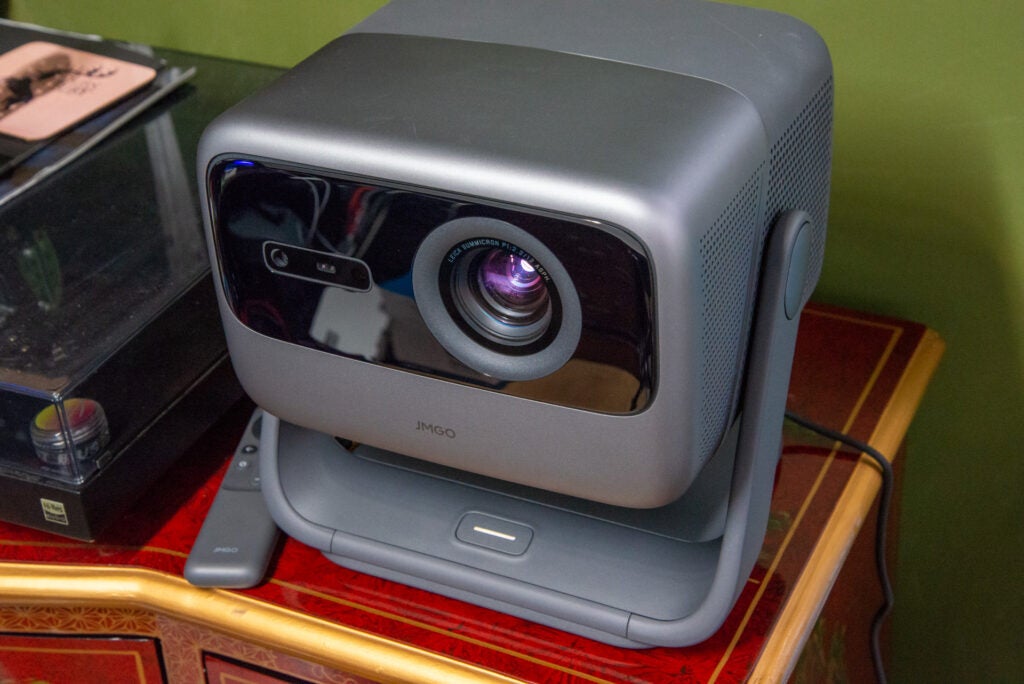
JMGO N1 Ultra
Best premium portable projector
Pros
- Extremely bright
- Excellent image quality
- Flexible stand
Cons
- Stand doesn’t have a tripod mount
- No native Netflix
It tends to be with portable projectors that their performance is compromised to their goal of portable, but that’s not the case with the JMGO N1 Ultra which can meet the demands of portable projector and deliver a high quality picture experience.
With a rated brightness of 4000 lumens, the JMGO is bright enough to get a reasonably sized image up on the wall during the day, though we still found that a darker room is best to produce an even bigger image. Unlike some of the other projectors that feature on this list, the N1 Ultra doesn’t output at a native 4K resolution. Nevertheless, we found it eked out lots of detail, sharpness and clarity from the content we watched in 4K.
Our reviewer noted its HDR10 support delivered bright images when watching Black Panther: Wakanda Forever, however black levels can verge towards grey.
The JMGO packs dual 10W speakers that deliver a big, loud sound with enough detail to hear dialogue being said, though bass is rather clumsily described.
The design features a built in gimbal that allows for plenty of flexibility in terms of where to point the projector, whether towards a screen, wall or ceiling. With its Autofocus and horizontal keystone correction, we found getting a square picture was easy enough, though a tripod mount would have been appreciate for more mobility and flexibility.
With two HDMI 2.1 inputs, one of which is dedicated eARC to connect a Dolby Atmos soundbar such as the Sony HT-A7000 or Sonos Arc, the N1 Ultra also carries Android TV integration that includes Google Assistant voice recognitions and plenty of streaming apps such as Disney+, BT Sport and Apple TV+. If you’re looking for Netflix, though, it’s not supported on this projector.
Reviewer: David Ludlow
Full Review: JMGO N1 Ultra

Samsung Premiere LSP9T
Best ultra short-throw projector
Pros
- Remarkably bright, colourful pictures
- Compact, living-room friendly design
- Built-in tuner and TV-like smart system
Cons
- It’s not cheap for this sort of projector
- Loss of colour finesse in very dark scenes with certain presets
- Rainbow effect
The Samsung LS9PT is an ultra short-throw laser with smart features make it more accommodating and accessible to those looking to ditch the TV and get an even bigger screen experience.
When we first reviewed it, its $6499 / £6999 price was considerably more than a similarly sized TV but its now down to £3500, which makes it an alternative option to an 83-inch TV. As an ultra short throw projector it can be placed close to a wall for the space conscious, and while it’s large for a projector, aesthetically its soft rounded corners and white colour can see it disappear in the right room.
The TV comparisons keep coming with its Freeview HD tuner for receiving daytime TV broadcast and smart system that apes Samsung’s Tizen version (not its most recent, we should add), and much like the LG HU85LS projector, it comes with a selection of apps that includes the likes of Netflix, Prime Video and iPlayer.
With 2800 lumens of brightness, that’s actually more than the JVC at the top of this list, which helps the Samsung mitigate the impact of ambient light in brighter rooms.
And like the JVC, the LS9PT also has a laser light source, which we found helped the Premiere deliver remarkably vibrant images with a wide range of colours that have more in common with a Samsung TV. With excellently sharp and detailed pictures with native 4K content, the LS9PT gives Sony’s highly regarded SXRD projectors a run for their money.
The sound is something of a revelation for a projector, avoiding sounding harsh or too bright, with plenty of detail to be heard and decent dynamism, though bass is a little restrained and lacking in depth.
Whether you’re looking to replace a TV with a big (projected) screen or are a home cinema fan, we feel the Premiere LS9PT works well to appeal to both segments.
Reviewer: John Archer
Full Review: Samsung Premiere LSP9T
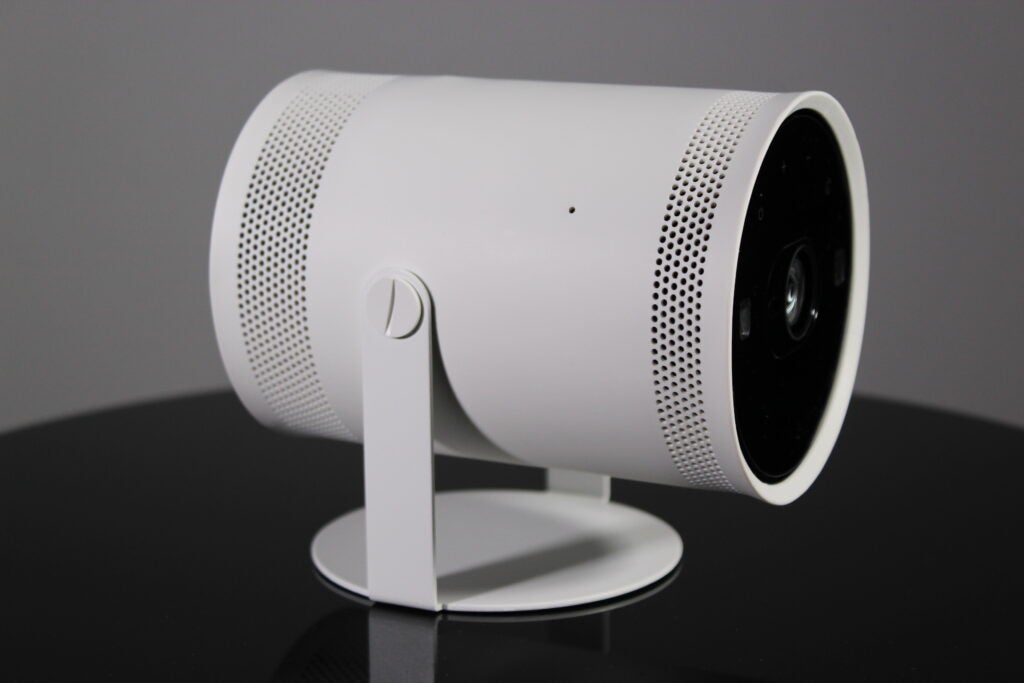
Samsung Freestyle
Best portable projector
Pros
- Easy-to-setup big screen images
- Surprisingly good sound
- Built-in streaming apps
Cons
- Limited to Full HD resolution
- Colour gamut could be wider
If the JVC and Samsung above in this list are too big to accommodate, as well as too pricey, then a projector that’s more down to earth is the Freestyle from Samsung.
It looks not unlike Luxor Jr. of Pixar fame, with its cylindrical shape and adjustable stand. We found the stand helped in both a decorative and practical manner, as it allowed the angle of projector to be moved from 90 to 180 degrees, and it can be used to cart the Freestyle around, emphasising its portable and compact design.
Its connectivity reflects its mobile nature with a micro-HDMI input that can accept HDR signals and supports eARC in case you wanted to add a soundbar. With the USB-C port (for the power adapter) and Micro-HDMI close together there’s limited space, so we feel that you’re better off using a dedicated HDMI to Micro-HDMI cable rather than an adapter.
Its wireless support expands it range of options with Wi-Fi 5, Wi-Fi Direct, plus Bluetooth 5.2 and Apple AirPlay 2. With Wi-Fi onboard you get the Tizen-powered smart platform, built-in Bixby and Alexa voice assistance along with SmartThings support, which our reviewer found helped make set-up much easier. Also making things easier is the Smart Calibration feature that allows images to be calibrated using a smartphone, compensating for colours if you’re watching on a wall that isn’t white.
The size of the image the Freestyle projects ranges from 30- to 100-incges by moving the projector closer or farther from a wall, and the projector allows for beaming images at any angle, so it could be pointed upwards to the ceiling if you want to watch in bed. It doesn’t make much noise at only 25dB from two feet away, so it shouldn’t cause much distraction when in use.
We found that the picture was very good, with 1080p images that appeared clean and detailed with HDR content offering more punch compared to SDR images. It could be brighter as with 500 lumens at its disposal, its not as bright as the XGIMI Halo+. The built-in speaker system is one we found to be surprisingly good for its size, producing a sound larger than the Freestyle’s dimensions. With an input lag of 44ms, it’s too high for serious gamers but fine for most people.
A new Freestyle has been announced that will likely replace this original model, though we are still waiting on word as to when it will arrive and how much it will cost. When it launches, it’ll support 21:9 screen ratios as well as Samsung’s Gaming Hub for cloud gaming.
Reviewer: Steve Withers
Full Review: Samsung Freestyle
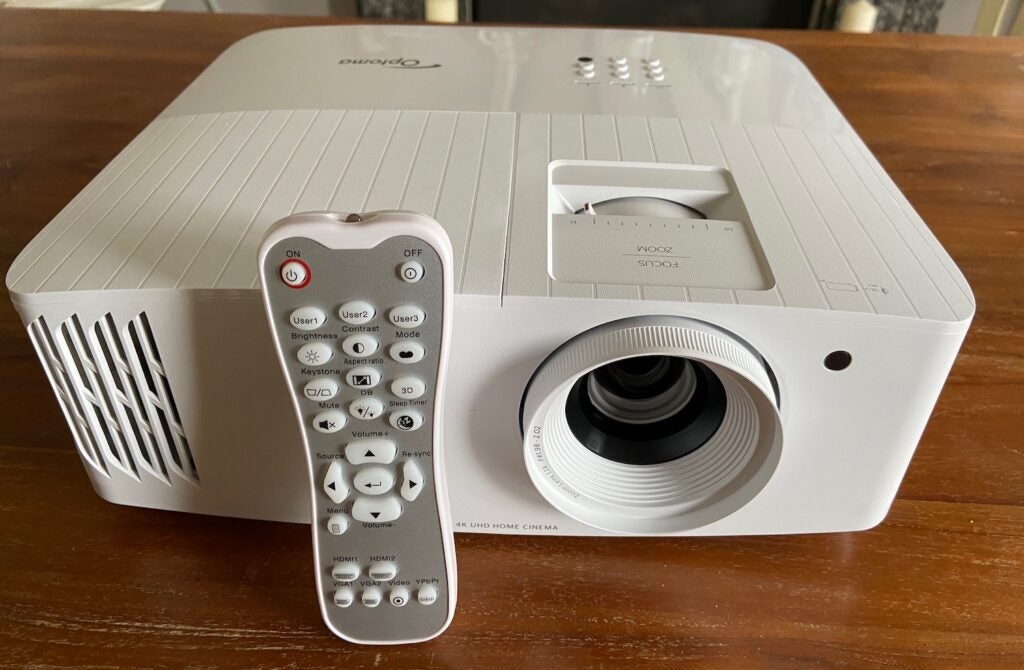
Optoma UHD38
Best affordable projector
Pros
- Seriously bright, crisp images
- Super-fast response time in Enhanced Gaming mode
- Bold colour and HDR performance
Cons
- Black levels are very average in HDR
- Some clipping with HDR
- Long-throw lens seems an odd choice for a gaming projector
The JVC and Samsung ultra-short throw projector are both capable of 4K resolution, but they’re also both expensive. If you’re after a 4K beamer for around $1000 / £1000, our current choice would be the UHD38 from Optoma.
It’s capable of 4000 lumens of brightness, which makes this an option for not only brightly-lit rooms but also garden use with its ability to fend off ambient light. We found the UHD38 is capable of seriously bright-looking images, with the brightness feeding the projectors wide colour range to produce rich red and blues for a colourful image.
It’s not without its constraints, however. While it supports HDR10 and HLG, it’s not a native 4K beamer though it can accept 4K signals. Black levels are shallow, which affects its ability to convey dark scenes well and restricts its HDR performance in a manner that doesn’t affect more expensive projectors. Its sound is clear and detailed and avoids feeling dislocated from the image on screen, faring better than most projectors, though to our ears it lacked much bass or dynamism.
First and foremost this is a gaming projector, and in its Enhanced Gaming mode we found it proved to be very responsive especially with high frame rates. Motion and pans are rendered well with no judder or noise perceptible, while our reviewer measured the input lag at 16.7ms, which is outstanding for a projector and can be reduced to 4.2ms when the projector is fed 240Hz images which is comparable to gaming TVs with VRR enabled.
This projector is made for the more casual home cinema fan rather than the enthusiast who watches in dark rooms. If that sounds like you and you’re also big into gaming, then the UHD38 warrants a closer look.
Reviewer: John Archer
Full Review: Optoma UHD38
FAQs
In some ways a projector is better than a TV, but it depends on what you want. If you’re after a big viewing experience then projectors are deliver an image much bigger than any TV can. However, TVs can go brighter, have a wider range of features and can operate in both bright and dark living room conditions. Not all projectors are bright enough to handle ambient light in bright rooms.


